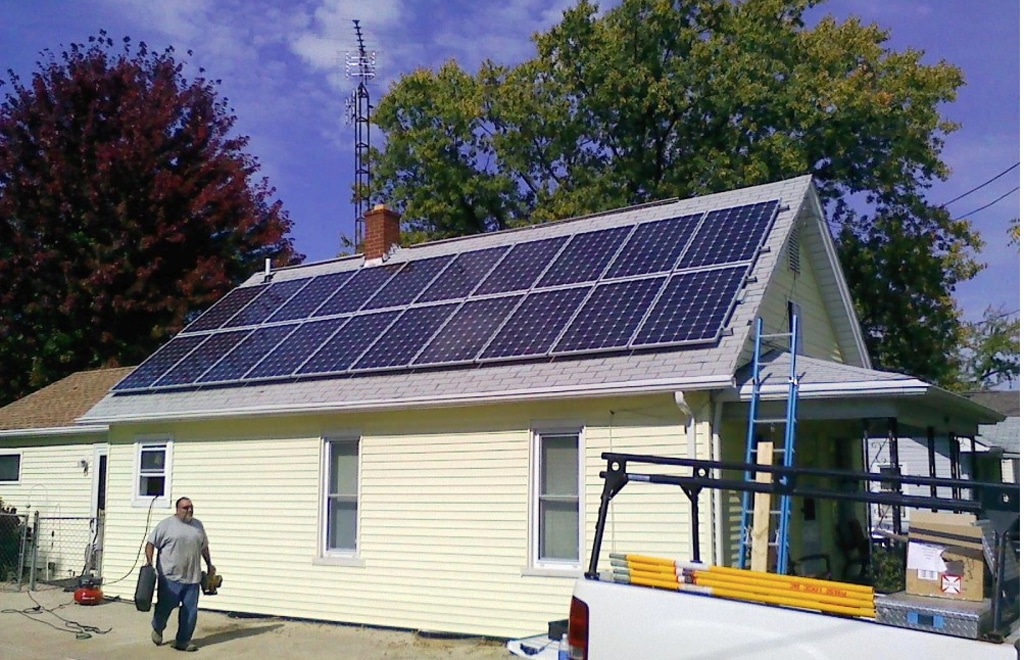The Michigan legislature met yesterday afternoon to pass a sweeping bill that increased the renewable portfolio standard (RPS) from 10 percent to 15 percent and created a deadline to implement a “grid” charge for future distributed-generation (DG) customers.
After more than 20 hours of negotiation, which included personal intervention of Gov. Rick Snyder in the wee hours of Thursday morning, the bill passed both houses of the legislature and only awaits Snyder’s signature. He had made the bill a priority for this legislative session.
The increased RPS means Michigan utilities will have to generate 15 percent of their electricity from renewable sources by Jan. 1, 2022. But the provision of the bill of most concern to solar advocates was the “grid charge,” a charge the utilities say they have to have on DG solar customers pay their fair share of grid upkeep.
(There is no evidence that solar customers harm non-solar customers by increasing costs on them. In fact, most studies show solar consumers are a net benefit to non-solar customers).
Under the provisions of the bill, the Michigan Public Service Commission (PSC) must establish a “nondiscriminatory, fair, and equitable” grid-charge by Dec. 1, 2017, though the PSC can implement it any time before that deadline.
Current DG solar customers are exempt from the grid-charge, as are customers who join a net-metering program before the PSC institutes it. Only customers who install solar after the grid-charge is instituted will pay it.
Reactions from solar advocates were mixed.
“The expansion of Michigan’s renewable portfolio standard represent a significant step forward for Michigan ratepayers,” said Liesl Eichler Clark, president of the Michigan Energy Innovation Business Council. “That said, the addition of an unnecessary grid charge on solar customers—particularly when distributed solar remains capped at 1 percent of our energy use—causes real concern, and the failure to interconnect Michigan’s two peninsulas is a missed opportunity.”
Similarly, The Alliance for Solar Choice (TASC) spoke about the potentially conflicting messages the bill sends to solar customers.
“We were encouraged to see elected officials from both sides of the aisle work to improve the bill to protect a consumer’s ability to generate their own electricity with solar,” said Amy Heart, a TASC spokesperson. “We still have serious concerns over how the distributed generation tariffs will be calculated based on the language in the bill.
“It’s now up to elected officials to help guarantee a fair, equitable process — and we look forward to working with Governor Synder and legislative leaders to ensure no discriminatory charges will be levied on solar customers going forward,” Heart added.
Other important provisions of the bill for solar advocates include:
- Moved the Michigan Renewables Energy Program from the PSC to the Michigan Agency for Energy.
- Maintained a 10-percent customer-choice carve-out, giving customers electricity choices outside of the state’s two major utilities.
- Defined “qualifying facility” (QF) as qualifying cogeneration facilities or qualifying small power production facilities from which an electric utility in the state has an obligation to purchase energy and capacity within the meaning of Sections 201 and 210 of the Public Utility Regulatory Policies Act (PURPA) and associated federal regulations and orders.
- Required the PSC to, at least every five years, conduct a contested case proceeding to reevaluate the procedures and rate schedules, including avoided cost rates to implement provisions of PURPA as it relates to QFs.
- Allowed, for small utilities (less than 1 million electric customers), the PSC to conduct periodic reevaluations using notice and comment procedures instead of a full contested case.
- Established an Energy Ombudsman, as of Jan. 1, 2017, to
- Serve as liaison for businesses and individuals by guiding energy issues, problems, and disputes to the appropriate entity, agency,or venue for resolution.
- Monitor activities of the PSC, Michigan Agency for Energy, and other state regulatory entities and communicate those entities’ decisions, policy changes, and developments to businesses and individuals. Issues to be monitored include renewable sources of energy, energy efficiency and net metering, among others.
- Convene regular meetings to share information and developments pertaining to energy issues, policies, and administrative processes affecting businesses and individuals in the state.
This content is protected by copyright and may not be reused. If you want to cooperate with us and would like to reuse some of our content, please contact: editors@pv-magazine.com.








By submitting this form you agree to pv magazine using your data for the purposes of publishing your comment.
Your personal data will only be disclosed or otherwise transmitted to third parties for the purposes of spam filtering or if this is necessary for technical maintenance of the website. Any other transfer to third parties will not take place unless this is justified on the basis of applicable data protection regulations or if pv magazine is legally obliged to do so.
You may revoke this consent at any time with effect for the future, in which case your personal data will be deleted immediately. Otherwise, your data will be deleted if pv magazine has processed your request or the purpose of data storage is fulfilled.
Further information on data privacy can be found in our Data Protection Policy.